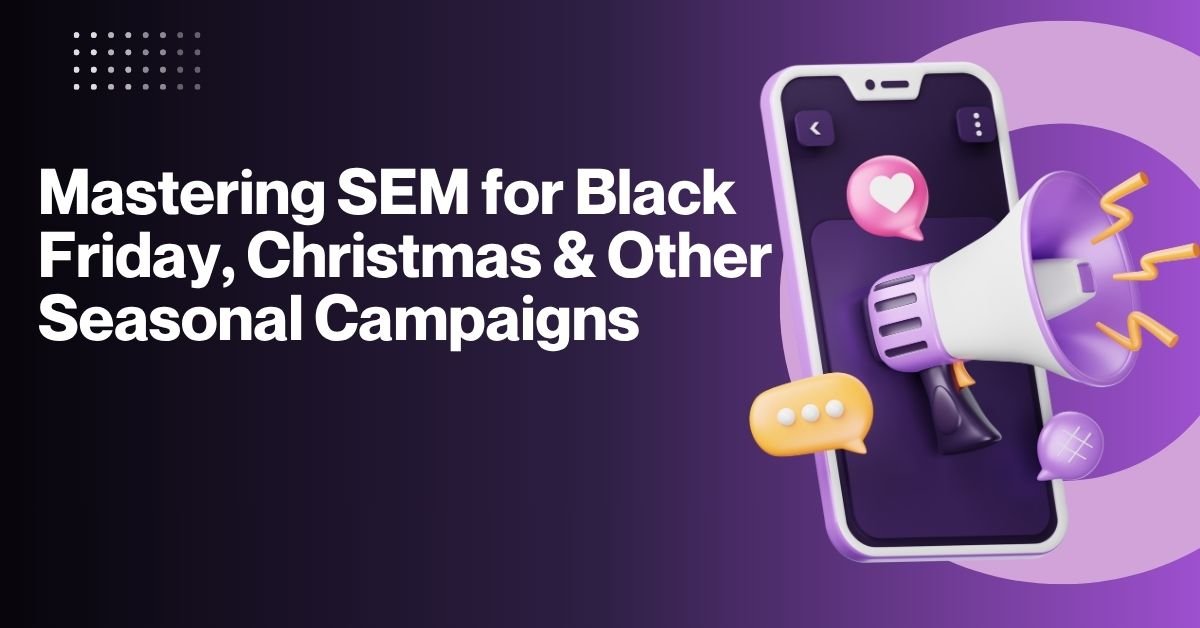
When it comes to running seasonal campaigns, there’s no doubt that search engine marketing (SEM) can be your secret weapon. Whether it’s Black Friday, Christmas, Valentine’s Day, or any other key shopping event, effective SEM strategies can bring more visibility to your brand, drive traffic to your website, and boost your revenue during these high-stakes periods.
This guide explores the ins and outs of SEM for seasonal campaigns. By the end of this post, you’ll know how to create, optimize, and execute SEM strategies that deliver results when they matter the most.
What Makes Seasonal SEM Different?
Seasonal SEM campaigns operate in tight timeframes with very high competition. Everyone wants to capitalize on the increased consumer interest, but not everyone knows how to stand out. What makes seasonal SEM unique lies in its temporary nature and the need for precise targeting, compelling offers, and agile execution.
Consider these factors:
- High Stakes, Limited Time: Seasonal events are short-lived. Black Friday, for instance, may attract the most online activity, but if you miss the mark, there’s no do-over until next year.
- Increased Competition: Cost-per-click (CPC) rates often skyrocket during seasonal events as more brands bid aggressively on keywords.
- Heightened Consumer Intent: Consumers during these periods are actively searching for deals, which means the intent is already there. The challenge is ensuring they choose your offer over others.
Mapping Out Your Seasonal SEM Strategy
To win the seasonal SEM game, preparation is everything. Here’s a structured approach to help you get it right.
1. Plan Well in Advance
While seasonal campaigns are temporary, the preparation for them should begin months ahead. This includes:
- Keyword Research: Identify high-performance seasonal keywords early. For example, search terms like “Black Friday deals 2024” often start gaining traction well in advance.
- Competitive Analysis: Look at trends and insights from competitors. Tools like SEMrush or SpyFu can reveal what worked in the past.
- Aligning Internal Teams: Coordinate with marketing, sales, and design teams to ensure your SEM campaigns integrate seamlessly with wider efforts.
2. Fine-tune Keyword Targeting
Seasonal campaigns call for a mix of:
- Event-Specific Keywords: These keywords focus directly on the occasion, such as “Cyber Monday laptop deals.”
- Product Keywords: Highlight the specific products or services you offer, such as “Christmas gift ideas for coffee lovers.”
- Localized Keywords (if applicable): Include information about geographic locations, like “holiday sales in Miami.”
Pro Tip: Leverage long-tail keywords to lower CPC while capturing purchase-ready traffic, e.g., “affordable Christmas gift sets under $50.”
3. Craft Attention-Grabbing Ad Copy
During seasonal rushes, effective ad copy can make or break your campaign. Keep these pointers in mind:
- Promote Time-Limited Offers: Use urgency triggers in your copy, such as “Hurry! Ends Midnight!” or “Only 2 Days Left!”
- Highlight Discounts or Free Perks: Be direct about offers like “Save 50% this Black Friday” or “Christmas Sale: Free Shipping on All Orders.”
- Use Seasonal Language and Emojis (where appropriate): Get creative with phrases and symbols, like “🎁 Holiday Sale!” or “Black Friday Blowout 🔥.”
Maximizing Campaign ROI with Smart Ad Tactics
Once your campaign is live, continuously optimizing it is critical for success. Here are tactics to maximize ROI:
1. Implement Ad Scheduling
Use Google Ads’ ad-scheduling feature to run ads during peak times when your audience is most active. For example, if data shows higher purchase intent on weekday evenings, allocate your budget accordingly.
2. Geo-Targeting
For businesses with a physical presence, geo-targeting ensures your ads are seen by customers in specific locations. Online-only retailers can also use it to allocate budget in regions with higher conversion rates.
3. Use Responsive Search Ads (RSA)
Responsive Search Ads allow you to A/B test ad copy dynamically and use Google’s machine-learning capabilities to serve the highest-performing combinations.
4. Retargeting Campaigns
Follow up with users who clicked but didn’t convert. Remarketing lists for search ads (RLSA) are excellent for re-engaging these audiences with tailored seasonal offers like last-minute discounts or exclusive bundles.
Budget Allocation Tips for Seasonal SEM
Competing during seasonal periods often means higher CPC. Here’s how to make the most of your budget:
- Set Clear Goals: Define what you’re optimizing for (e.g., revenue, leads, ROAS) and align your bidding strategy accordingly.
- Focus Budget on High-Performing Keywords: Use your historical performance data to determine the best-performing keywords worth investing in.
- Assign a Contingency Budget: Seasonal campaigns can be unpredictable. Having a reserve budget lets you capitalize on unexpected successes or compensate for poorly performing ads.
Measuring Success and Iterating for Improvement
After wrapping up your seasonal campaign, it’s time to analyze performance. Key metrics to track include:
- Click-Through Rate (CTR) – Indicates the effectiveness of your ad copy and targeting.
- Cost-Per-Acquisition (CPA) – Shows how efficiently your campaign drove conversions.
- Conversion Rate – Measures the percentage of visitors who completed an action (e.g., purchase or sign-up).
- Impression Share – Helps you understand how often your ads were shown compared to competitors.
Use these insights to refine next year’s campaigns further and build data-backed strategies.
Why SEM Matters for Seasonal Success
Mastering SEM for Black Friday, Christmas, and other seasonal campaigns isn’t just about running ads; it’s about understanding how customer intent spikes during these periods and ensuring your brand is front and center. With careful planning, targeted keywords, compelling ad creatives, and smart optimizations, you can turn high-stakes seasonal events into your biggest wins of the year.
If you’re ready to take your SEM campaigns to the next level, start implementing these strategies today and race ahead of your competitors when it matters the most!


Leave a Reply